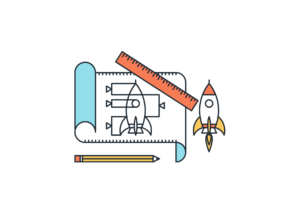
02 Sep Prototype vs MVP: Understand Key Differences to Choose the Right One
Nobody wants to build a product that fails—wondering why do some businesses fail with their new products? Well, this is where prototype and MVP come into the picture. A product that doesn’t undergo testing fails faster. In contrast, a product that meets customers and business needs in every stage of its development process wins. Prototype and MVP (Minimum Viable Product) are two critical parts of product development. They help you learn if the product is a success or a flop at the earliest stage. Simply put, they are the earlier versions of your final product. When you develop them rightly, your product fits in a good market.
Introducing a new product in this ever-changing business environment involves many steps. Changes in workflow, interactions, and sometimes product ideas are common if you don’t build a product that your customers need. These cost a fortune if your product is in the market already.
Prototype and MVP help you avoid expenses by identifying the market and customer’s response without spending months or a year on the product. This is why these two terms are popular among tech companies. However, most people often confuse the two. This article explains the difference between Prototype and MVP to help you build successful products that people need. Before that, let’s understand Prototype and MVP and how they impact product success briefly.
What is a Prototype?
A prototype is a sample of your product in theory form. It is the first crude design of your product development process. However, not every prototype ends as a final product. The advantage of prototypes is you can communicate your idea and design with the developers or designers easily. You can show them what exactly they need to build.
Prototypes can be as simple or as complex based on your requirements. They can be paper sketches or digital prototypes and vary in size, time, and effort based on your resources and needs.
Paper sketch prototype
Although prototyping is a critical part of product development, you need not invest hugely and use all resources to make your idea tangible. A pencil is all enough if you can handle it. The paper sketch comes into use when you want to communicate your idea with investors or stakeholders in a visually pleasing way.

Digital prototype
There are plenty of tools to help you design a prototype. Companies can go for digital prototypes if the design is complex and the budget allows. However, ensure you pick the right one with not more than necessary features to save money.
What is MVP?
The term MVP (Minimum Viable Product) is an earlier version of your product that works and solves your customer’s problems.
Eric Ries, the author of The Lean Startup, who also popularized the term MVP, described it as – “A Minimum Viable Product is that version of a new product which allows a team to collect the maximum amount of validated learning about customers with the least effort.”
Simply put, MVP is a product with a minimum set of features that provides value to the early customers and helps you start learning customers and finally launch the product that they need.
Now that you know what are prototypes and MVP and their importance. Now let’s understand their difference.

Difference between Prototype and MVP
The primary difference between prototype and MVP is that prototype is not a product but just a representation and comes before MVP, whereas MVP is a functional product.
To help you understand better, we broke down the differences into three parts.
1. Time to build
Prototypes are easy to create; they can be on paper or computer using tools. They don’t require much time or effort, and they can be easily changed or modified upon discussion with the team.
This isn’t the case with MVP. It takes time to develop an MVP as it should be functional with more people involved in the product and should be impressive to make customers wait for the actual product.
2. Audience
Prototypes are for internal communication. They are intended for your team members, stakeholders, and investors to take your idea into action, whereas an MVP is built for customers. It will be available for the public to test if it’s really working or need more changes. You can make the final product and launch it with the insights you’ve gained with MVP.
3. Flexibility
As said, it’s easy to scrap the prototypes and start from scratch again with no extra costs. You can learn and develop a new idea or unlearn and completely change your idea at this stage.
When it comes to MVP, it isn’t easy to throw it away once you made it. Although you may have to make drastic changes due to changed market conditions, it’s still painful.
So, now you may wonder which one to choose for your new product development.
Prototype or MVP: Which One to Choose?
Both prototype and MVP are product development approaches that are designed to validate the product idea and functionalities. Choosing one for your product development ultimately depends on your product idea.
Say, if your concern is feasibility and you’re unsure if people want it or not, prototyping is the best option. As said earlier, it is intended for internal people (stakeholders or teams) for validation. Whereas if you know your idea is practical and works out, building an MVP saves you time and helps you reach your audience faster.
Wrapping Up
The best time to test your product is during its early stage, and the best way to build a successful product is to launch an MVP before the product launch. Modern products have to go through all product development stages to ensure a successful outcome.
Prototyping and MVP are critical approaches, and choosing between the two for your product development shouldn’t be that difficult. Hope this article helps you understand the difference between them and help you pick a wise strategy to build a product that fits the market.




